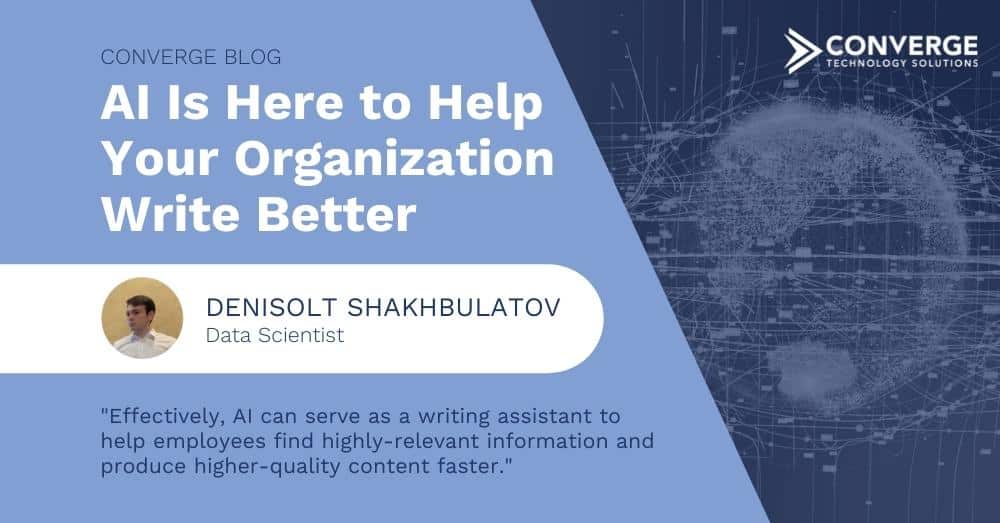For many companies, writing is a core part of doing business. Whether it’s creating a project proposal, a sales pitch, or a legal document, organizations need their skilled employees to write long-form, detailed pieces of content to move projects forward, share institutional knowledge, and guide strategy.
Companies like banks and law offices, for example, have treasure troves of existing content that probably required a lot of expert time and energy to create. Too often, these valuable knowledge assets go underutilized in the creation of new content. When tasked with writing a new piece of content, it can be a huge challenge for employees to find the right information and expertise, and then write content that is compelling, well structured, and written in the right brand voice.
Think for a moment about your company’s writing needs. Are there pieces of writing that are important to your core operations? Would it benefit your organization if this content was easier and faster to produce? For many companies, it would.
The emergence of AI-powered writing assistants
Thanks to some recent developments in the world of natural language processing (NLP), it’s now possible for organizations to put the tools of AI at their employees’ fingertips. Effectively, AI can serve as a writing assistant to help employees find highly-relevant information and produce higher-quality content faster.
At the most basic level, an AI writing assistant can make suggestions to improve things like grammar, sentence structure, word choice, and brand tone of voice. But AI can do much more than that when you train it on your organization’s catalog of existing content. It can understand sentence context, semantic meaning, company jargon, and make connections across all of these content data.
This unlocks lots of possibilities. Based on the meaning of the sentences your employees write, AI can find and serve up highly-relevant information from your catalog of existing content. This can be done using transformer models, pioneered by Google BERT. Here, AI takes a sentence or collection of written words and finds the most similar sentences, from previous written work, based on the semantic meaning of the entered text.
To go a step further, AI can even complete sentences and offer suggestions for whole paragraphs of content. Text generation technology like OpenAI’s Generative Pre-Training Transformer (GPT) or Google BERT make this possible. To get a sense of how this works, check out the AI community, Hugging Face, which provides demos where you can type in text, and GPT will autocomplete the next sentence or two for you. You may even be using this technology without even realizing it: The text autocomplete feature in Gmail uses BERT.
AI-powered writing assistants can be much more than just grammar checks and autocomplete. With technology like this, AI can also be used for searching information across different domains. Need a stock picture that complements your sales deck or a list of subject matter experts within your organization? NLP is your answer.
NLP in action at a global development bank
At Converge, we are using a collection of these NLP technologies to improve proposal writing at an international development bank. An important part of the bank’s business is writing proposals to fund projects in different countries. However, it was proving difficult for proposal writers to locate other employees in the organization with expert knowledge about certain topics.
To solve this, we looked at the bank’s employee data and existing documents—such as project proposals, publications, and blogs. And then, we utilized all of their data to build language models for them, which create relationships between associated terms that are important to their organization.
As a result, we were able to create a search engine that can efficiently locate knowledge experts. Now it takes only a single search to find a subject matter expert instead of 10+ email chains. After each project, teams write up key lessons learned, which can be valuable for future proposals. Using Google BERT, we used AI to serve up the most relevant lessons learned. This tool is now helping proposal writers save time, create better proposals, while leveraging institutional knowledge to help people in developing countries.
Key next steps in exploring NLP tools
Every business is unique, so there isn’t one exact path to using NLP tools. A great first step is to start a conversation internally about the particular writing needs of your organization and what kind of value you could gain by supporting the process with AI.
It’s also important to remember that AI is only as good as the data it works with. When pursuing NLP technologies, it’s critical to catalog your existing data—e.g., by content, region, and author—so the AI can access it and find experts in your organization who have helpful information related to the text that’s being written.
With the right approach, organizations can use AI to improve writing, better connect knowledge, and get more value from existing investments. Now is a great time to explore what AI can do for your writers and your organization.




